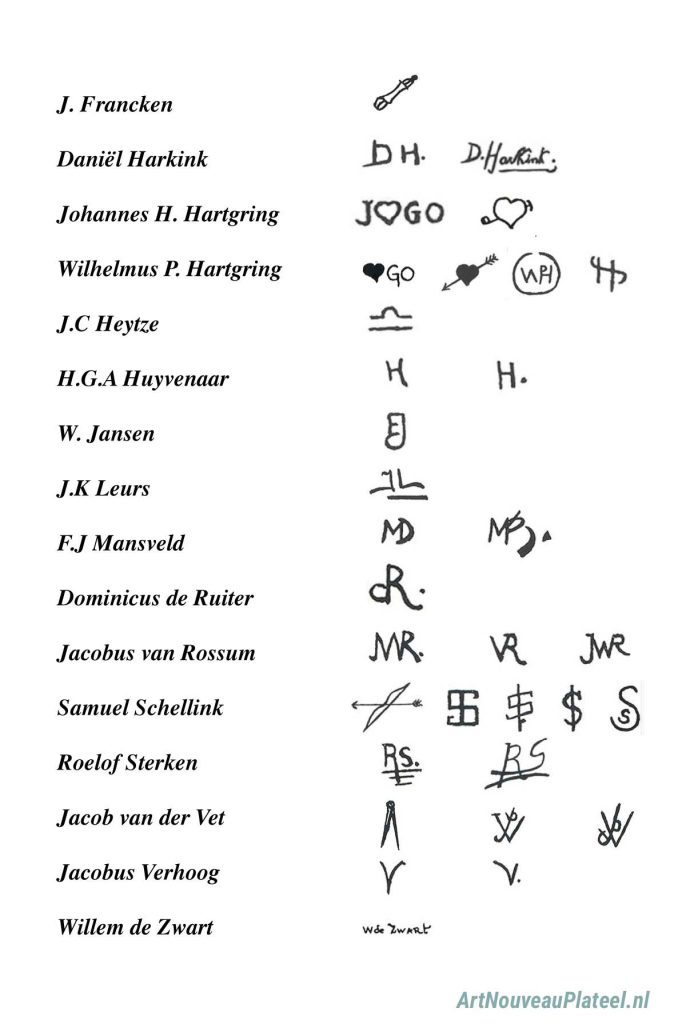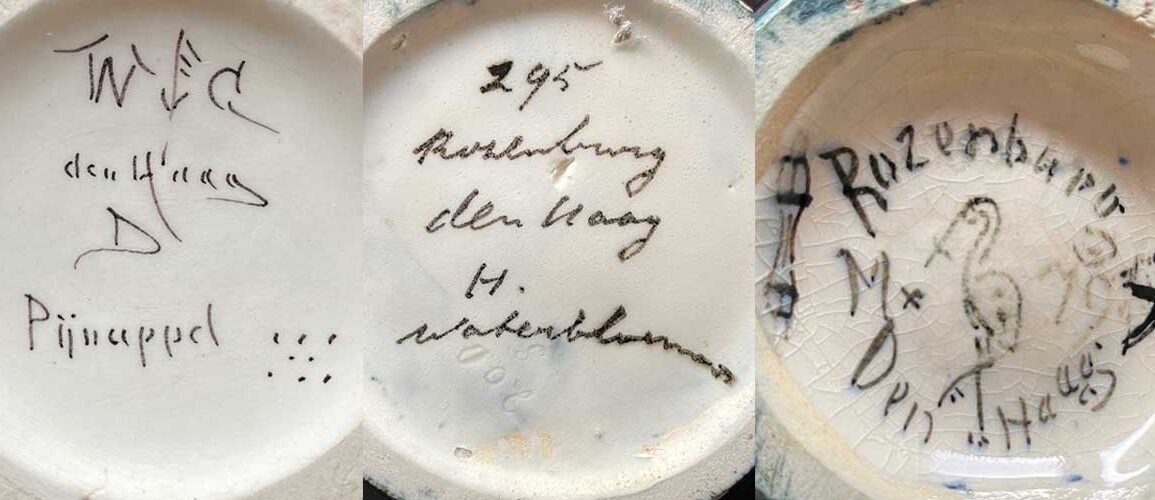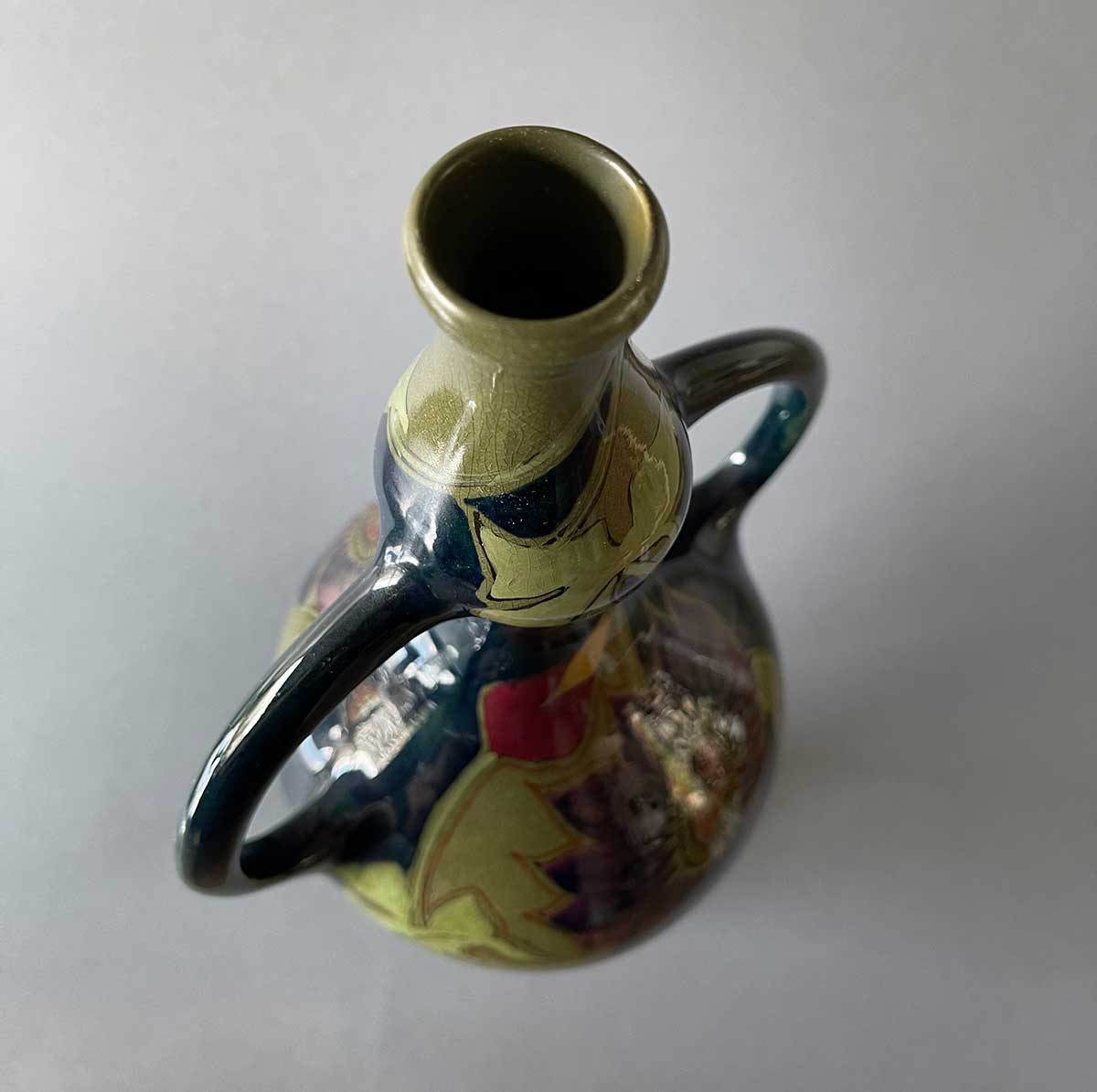How old is an antique Rozenburg Pottery vase? Who painted it? And what do the marks on the bottom of the objects mean? In this article we explain how you can find out more about your Rozenburg vase.
A short history of Rozenburg Pottery
The royal Rozenburg Pottery Factory from The Hague in the Netherlands existed between 1883 and 1917. In the heyday of the Art Nouveau or Jugendstil period in the Netherlands, the Rozenburg factory produced art pottery that was renowned and traded all over the world. Read the article about the history of the Rozenburg factory in The Hague here.
Different factory logos of the Dutch Rozenburg pottery company
An important indication of the age of Rozenburg objects is the presence of the factory logo. Various logos have been used in the history of the Rozenburg pottery factory in The Hague, and they have all changed over the years.
First production period 1883-1885
No logos were used in the first production period of the Rozenburg pottery factory in The Hague, Holland. The factory, led by German director Wilhelm von Gudenberg, was not yet known by the name of Rozenburg. The company was founded under the name N.V. ‘s-Gravenhaagse Kunstaardewerkfabriek (The Hague Art Pottery Factory). Pottery didn’t have any year marks applied during this period.
WvG: period 1885-1889
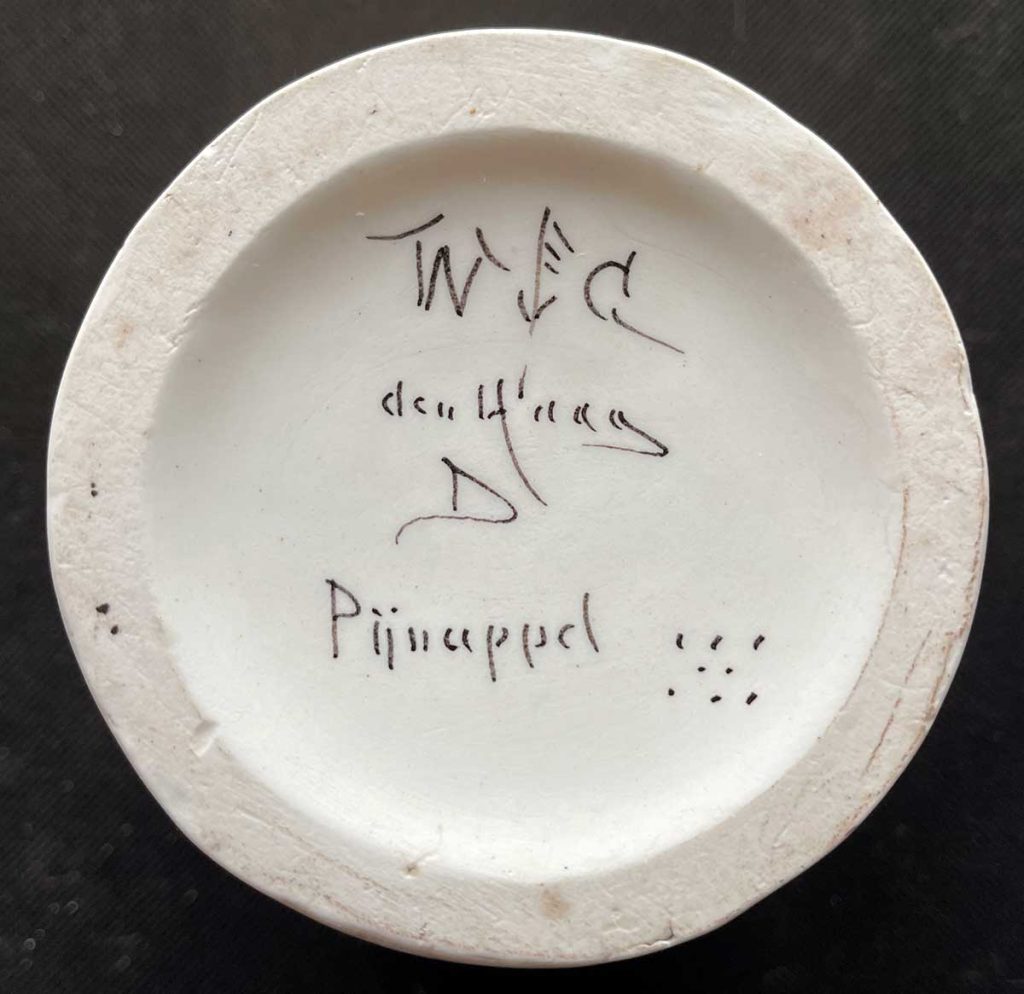
In 1885, the predecessor of Rozenburg Pottery Company moved from Boekhorststraat in The Hague to the former country estate of Rozenburg, at the edge of the city. In this period the first marks appeared at the bottom of the pottery. This logo consisted of the initials of Wilhelm von Gudenberg, the letters WvG. A flagstick was depicted in the middle of the V. Below that the place name Den Haag (The Hague) was used.
In this period, the Rozenburg factory worked with year marks. The year 1885 was given the letter A, 1886 = B, 1887 = C, 1888 = D and 1889 = E. Sometimes the name of the decor is also mentioned. These are usually names of flowers or plants in the Dutch laguage.
Rozenburg Pottery: period 1889-1893
Halfway through the year 1893, the brand name Rozenburg appears on the bottom of Rozenburg pottery pieces. Again provided with the place name indication: Den Haag (The Hague). This coincided with the departure of Wilhelm van Gudenburg, who was dismissed by the supervisory board of the pottery factory due to continued losses, the messy administration and poor leadership. The year letters are also used again. 1889 = E, 1890 = F, 1891 = G, 1892 = H, 1893 = K. It is striking that the letters I and J are skipped.
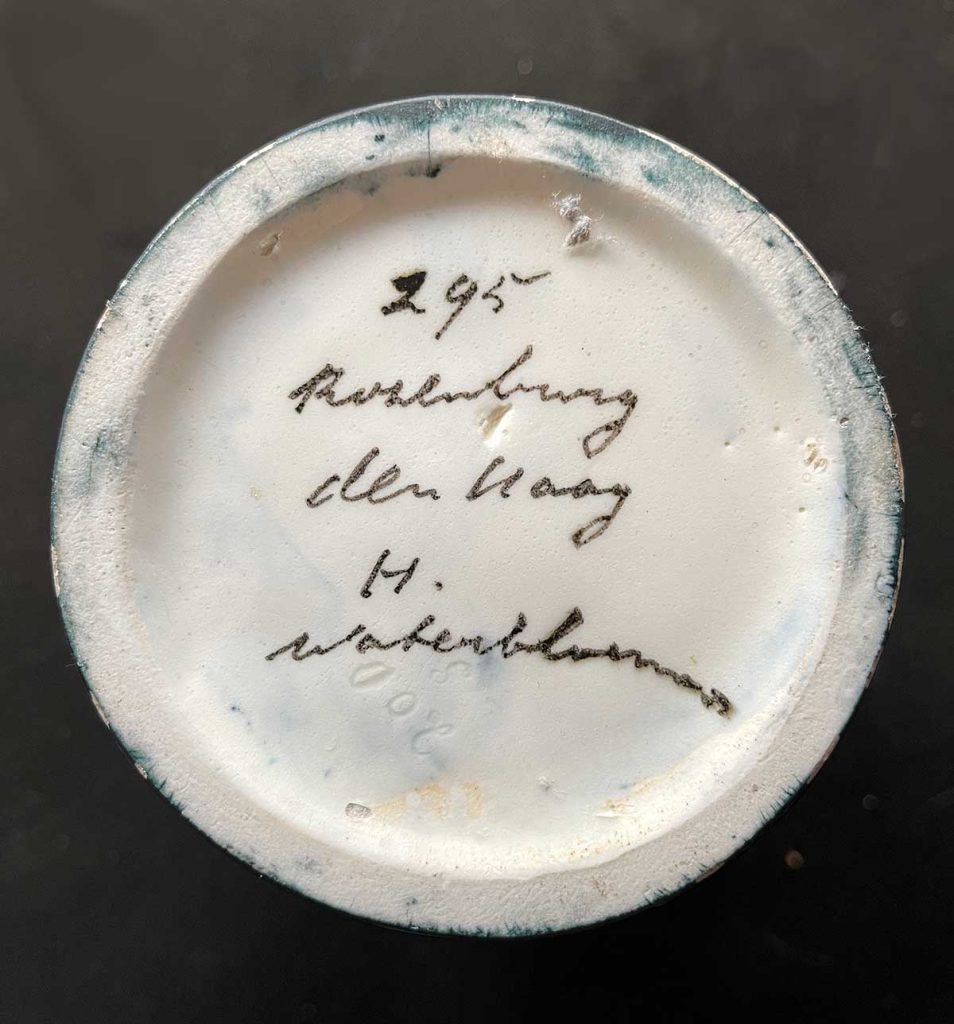
Rozenburg Pottery: period 1893-1898
In the year 1893 the logo of the stork appears. The stork is also featured in the coat of arms of The Hague. With the choice of this large bird in the logo, the Rozenburg factory wanted to emphasize its roots in The Hague. The year letter is carried through to the letter N. So 1893 = K, 1894 = L, 1895 = M, 1896 = NK, 1897 = K circled, 1898 = KP. The fiat signs also appear in the form of a cross or a diamond during this period. With this, the chief of the painting room signed off painted vases for approval.

Rozenburg Pottery: period 1898-1914
In 1898 the first year signs appear. Each year had a different symbol, below you can see an overview. In the year 1900, a crown also appears above the name Rozenburg, because the factory was given the ‘royal seal of approvement’. From October 31 in 1900 the factory changed it’s name again and was officially called: Royal Porcelain and Pottery Factory Rozenburg. The marks are also given a fixed place on the bottom of the objects. At the top of the crown, below that the name Rozenburg. In the middle the stork and at the bottom the place name The Hague. To the left of the stork is the year sign and to the right of the logo is the monogram of the painter or designer and a work order number.

Overview year marks Rozenburg pottery

The letter M and the letter M with an x stands for the year 1895.

The combination of the letters N and K stands for the year 1896. Until August 25, 1896, the cross is used as an approval sign.

The combination of the letters N and K stands for the year 1896. From August 25, 1896 to November 1, 1896, the diamond or window is used as an approval sign.
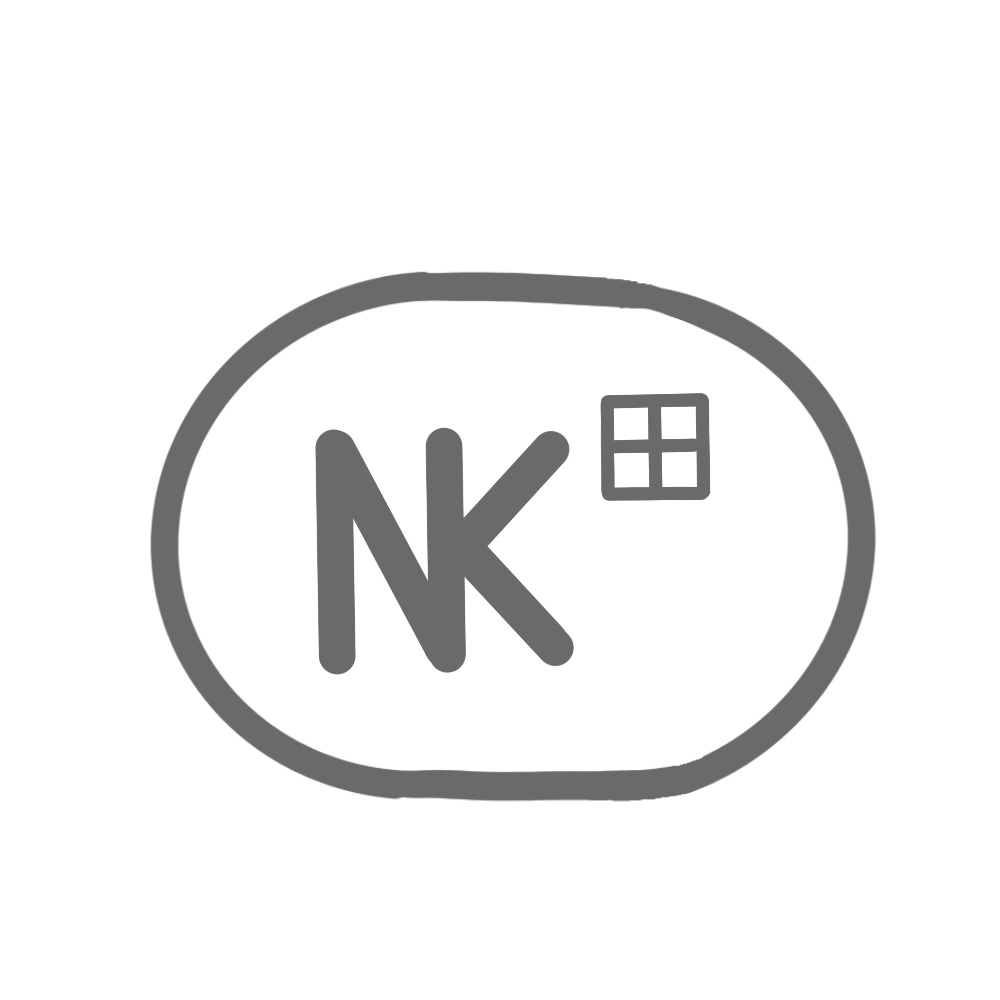
The combination of the letters N and K stands for the year 1896. From November 1, 1896 to December 11, 1896, the letters N and K are encircled. Approved vases receive the window as an approval sign.

The letter K is used for the period between December 12, 1896 and December 10, 1897. The K is encircled and the diamond or window is the approval sign. The combination of the letter K and P is used in a short period in December 1897.

The crown is the first year mark with a symbol. The crown is used between December 18, 1897 and December 15, 1898 by the Dutch Rozenburg Pottery factory.
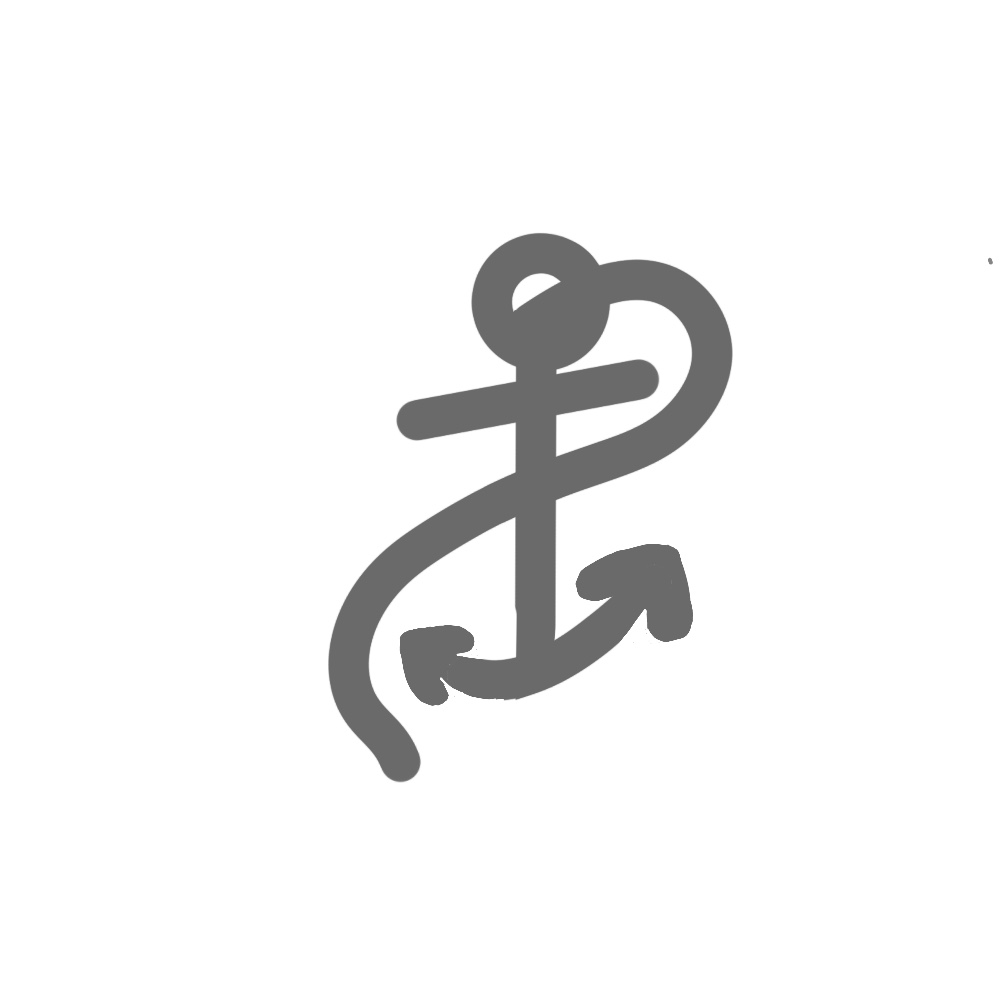
The anchor is the symbol used by Rozenburg in the period between December 16, 1898 and November 30, 1899.

The bee or anything resembling a flying insect is the symbol used to date Rozenburg pottery between the period December 1, 1899 and December 1900.

The ant is used for the period January 2, 1901 and December 6, 1901.

The symbol of a sun with sunbeams symbolises the period mid-December 1901 and December 8, 1902.

Between December 15, 1902 and December 14, 1903, the symbol of a star with dots, a star with rays or a diamond with dots is used to date Rozenburg pottery.

A flag with flagpost is the symbol for the year 1904. It is used between December 15, 1903 and December 26, 1904 by the Rozenburg Pottery company.

This symbol is used from December 26, 1904 to the end of December 1905.

This symbol is used by the Rozenburg Pottery factory from the Hague between December 30, 1905 and the end of December 1906.

The hourglass is the symbol for 1907. It is used between January 4, 1907 and December 28, 1907. Sometimes with one or two dots.

A setting sun in the waves is the symbol for 1908.

A burning torch is the symbol, used by the Rozenburg Pottery and Porcelain Factory from the years 1909 and 1910.

In 1911 and 1912, the use of year marks came to a halt. The tree returns in 1913. From January 1913 to the end of December 1913, Rozenburg pottery is marked with a small tree.

1914 was the last year of production year at the Rozenburg factory in The Hague. Pottery from this year is marked with a moon. The moon can also be smooth or orbited.
Marks and signs of Rozenburg Pottery painters
In the period between 1883 and 1914, many different craftsmen worked at the Dutch Rozenburg factory in The Hague. Some worked as designers of objects, others as designers of decors and others were responsible for the painting of the pottery. Not all Rozenburg objects have a monogram of the painter or the designer. And if a vase, a wall charger or an ewer is signed, it is not always clear whether the monogram or the symbol belongs to the decor designer or the painter. It is therefore difficult to determine who made a Rozenburg vase. It is better to consult the work order books, which have been preserved and (fortunately) made digitally available by the Hague Municipal Archives.
Below is a list of common signatures and the name of Rozenburg employees. Note: the list is far from complete. A good source (also for this article) is the book Rozenburg 1883-1917 that was published (in the Dutch language) in 1983 by the Kunst Museum in The Hague.
